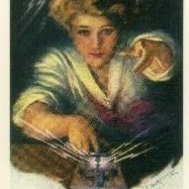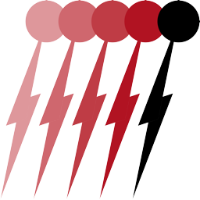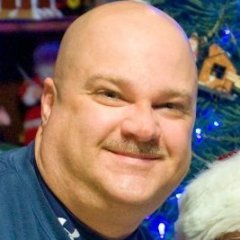NS7X's Achievements
-
I had a grand time today working with middle school and high school students. (Good God! Was I ever THAT young?) I was with a group of amateur radio operators who had set up a demonstration for the kids who attended one of Albuquerque's charter schools. Our ham group had everything from talking to the International Space Station, to packet radio, to communicating around the world.
I, of course, was there amongst all the fancy high-tech radio stuff with my good, old-fashioned, low tech, Morse code key. Suffice it to say, I was not the most popular exhibit, but I think I did hold my own. And I met a few incredible kids with a natural knack for CW (Morse code).
Many of the kids had some pretty profound questions and comments. ("Hey, lady, I've been really hungry for a good doughnut lately.") We talked about the history of Morse code, and why it's still used today. ("Hey, lady, I can't remember the last time I ate a good doughnut.") I explained that CW is simply texting that you can hear. ("Hey, lady, I really love a good doughnut.")
The doughnut kid had apparently noticed (smelled?) a box from Dunkin' Doughnuts which had been stored under my table. I had no idea who brought the doughnuts, that is - whose doughnuts they were - so I opted to ignore the doughnut kid, and his not-so-subtle hints.
I taught several of the kids how to send their name in Morse code. Man, they really loved that! ("Hey, lady, I sure could use a doughnut about now.") There was this one young girl, beautiful girl, named Olivia who took to learning the code like a fish learns to swim. She couldn't get enough of it. ("Hey, lady, did you know that there is a box of doughnuts under your table?")
Well, to make a long story short, there were several kids who really seemed to enjoy learning about modern ham radio communications, including Morse code, and one kid who eventually found the owner of the doughnut box under my table and, according to him, got permission to pick out a doughnut, which made that kid very happy.
It was a long day for me, and at the end of the day I packed up my gear anxious to get home and take a nice long nap. But, I had one final encounter with one of the students. "Hey, lady, mind if I give my girlfriend a doughnut?" -
For the "Rumors" file: ("Do you have a rumor about new gear, new regulations, new laws... feel free to post them here!")
I have heard that the FCC has suspended initial license applications on this date (April 26, 2023) indefinitely as a result of questionable VE activity in the testing of new (excluding upgrades) amateur radio license applications. It is my understanding that an FCC investigation is active at this time. I have attempted to track this rumor down without success. Has anyone heard about this? Does anyone have any information about the veracity of this rumor? -
Saturday marked the first anniversary of the day my OM, Bob, died. It was an anniversary I was dreading. Yet, so many things seemed to come together this last week as if that awful first anniversary was in itself a nexus. For example, I got word that my beloved husband's tombstone had been completed and was ready to be installed. Saturday, the 81 st anniversary of the Fall of Bataan was commemorated here in Albuquerque - an event that Bob was an integral part of the planning of. And I don't know why, but I chose this week to finally report to the FCC that Bob was a silent key. Suffice it to say that it's been a tough week.
I noticed today that QRZ.com lists Bob as a silent key. So I guess it's a done deal, and his call will now be up for grabs. He loved his call dearly, and was awfully proud of it. And, yes, it was a vanity call.
You see, Bob was a big fan of Buddy Holly. As far as Bob was concerned, the day Buddy was killed in that tragic plane crash in Iowa was truly "the day the music died."
When Bob upgraded from tech to general, he began looking for a new call. When he learned that the callsign K5PSG was available he jumped on it, and got it! You see, K5PSG was originally the call of Peggy Sue Gerron (PSG)who was not just a ham, but was the girlfriend of one of the Crickets - Buddy Holly's band. Not only that but she was THE "Peggy Sue" made famous by the Buddy Holly song. So, suffice it to say, Bob not only loved being a ham, but he also loved his unique tribute to the great Buddy Holly.
Here's to Peggy Sue, and Bob Cornett - both of them made the call K5PSG pretty darn cool.
-
-

Thank you, Jim, for your kind comments.
I have a good ham friend here in Albuquerque who also lost his spouse in the last year. We've been crying on each others' shoulders a lot, sharing our grief. He described what it's been like for the both of us when he said, "I wouldn't wish this pain on anybody."
-
10 newly posted or edited posts
-
Christmas on the Rhine Boat Trip Started
-
Last Minute Items Started
-
Volunteer Update Emails Started
-
Flashlights left at MCM Check-In Started
Quick Menu
- Ham Community - Homepage
- Ham Boutique - Get your farkle
- Ham Census - Shape the future of Ham Radio
- Ham Weblinks - Curated links
- Ask the Elmers - Direct access
- Ham Quizzes - Keeping you sharp
- Ham Tutorials - Learn from the best
- Ham Speakers - Give a talk, find a speaker
- Ham Volunteers - Organize and volunteer
- Support - For site or boutique problems









